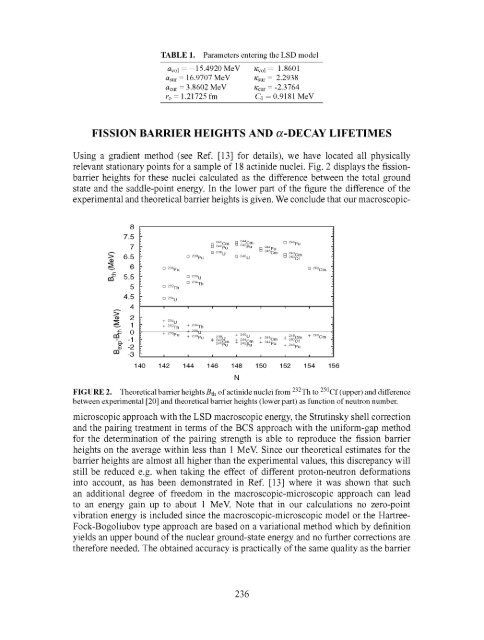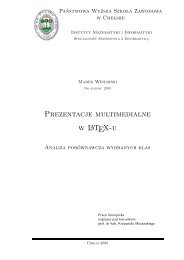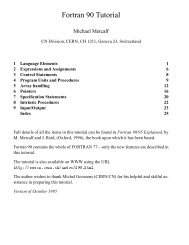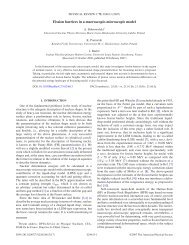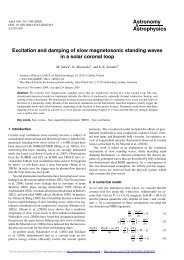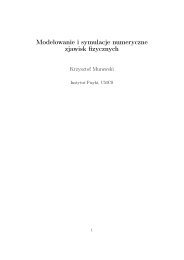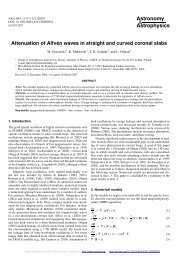Fission barrier heights and lifetimes for heavy and superheavy nuclei
Fission barrier heights and lifetimes for heavy and superheavy nuclei
Fission barrier heights and lifetimes for heavy and superheavy nuclei
You also want an ePaper? Increase the reach of your titles
YUMPU automatically turns print PDFs into web optimized ePapers that Google loves.
TABLE 1.<br />
avoi =-15.4920 MeV<br />
asur= 16.9707 MeV<br />
acur = 3.8602 MeV<br />
To = 1.21725 fm<br />
Parameters entering the LSD model<br />
K-voi= 1.8601<br />
Ksui= 2.2938<br />
Kcur = -2.3764<br />
C4 =0.9181 MeV<br />
FISSION BARRIER HEIGHTS AND a-DECAY LIFETIMES<br />
Using a gradient method (see Ref. [13] <strong>for</strong> details), we have located all physically<br />
relevant stationary points <strong>for</strong> a sample of 18 actinide <strong>nuclei</strong>. Fig. 2 displays the fission<strong>barrier</strong><br />
<strong>heights</strong> <strong>for</strong> these <strong>nuclei</strong> calculated as the difference between the total ground<br />
state <strong>and</strong> the saddle-point energy. In the lower part of the figure the difference of the<br />
experimental <strong>and</strong> theoretical <strong>barrier</strong> <strong>heights</strong> is given. We conclude that our macroscopic-<br />
><br />
^<br />
CD<br />
><br />
2<br />
m<br />
X<br />
CO<br />
7.5<br />
7<br />
6.5<br />
6<br />
5.5<br />
5<br />
4.5<br />
4<br />
2<br />
1<br />
0<br />
-1<br />
-<br />
-3<br />
n 23ep^<br />
n<br />
232T-„<br />
n 234y<br />
+ 2S*U<br />
+ 232Th<br />
+ ^*PU<br />
,<br />
D<br />
D<br />
D<br />
23Bp^<br />
236^<br />
+ 2S*Th<br />
+ 23Bp„<br />
B<br />
D<br />
+<br />
^<br />
238^<br />
238..<br />
240^ni<br />
H 2lJgn<br />
240y<br />
+ 2*"U<br />
140 142 144 146 148 150<br />
,<br />
N<br />
+ »«cm<br />
+ »*Pu<br />
,<br />
n 24ep^<br />
B gSgm<br />
* 2Sg["<br />
+ Pu<br />
,<br />
n 260(,m<br />
+ 26"cm<br />
,<br />
J<br />
-<br />
-<br />
•:<br />
-<br />
-,<br />
i<br />
-<br />
152 154 156<br />
FIGURE 2. Theoretical <strong>barrier</strong> <strong>heights</strong> Sth of actinide <strong>nuclei</strong> from ^^^Th to ^'"Cf (upper) <strong>and</strong> difference<br />
between experimental [20] <strong>and</strong> theoretical <strong>barrier</strong> <strong>heights</strong> (lower part) as function of neutron number<br />
microscopic approach with the LSD macroscopic energy, the Strutinsky shell correction<br />
<strong>and</strong> the pairing treatment in terms of the BCS approach with the uni<strong>for</strong>m-gap method<br />
<strong>for</strong> the determination of the pairing strength is able to reproduce the fission <strong>barrier</strong><br />
<strong>heights</strong> on the average within less than 1 MeV. Since our theoretical estimates <strong>for</strong> the<br />
<strong>barrier</strong> <strong>heights</strong> are almost all higher than the experimental values, this discrepancy will<br />
still be reduced e.g. when taking the effect of different proton-neutron de<strong>for</strong>mations<br />
into account, as has been demonstrated in Ref. [13] where it was shown that such<br />
an additional degree of freedom in the macroscopic-microscopic approach can lead<br />
to an energy gain up to about 1 MeV. Note that in our calculations no zero-point<br />
vibration energy is included since the macroscopic-microscopic model or the Hartree-<br />
Fock-Bogoliubov type approach are based on a variational method which by definition<br />
yields an upper bound of the nuclear ground-state energy <strong>and</strong> no further corrections are<br />
there<strong>for</strong>e needed. The obtained accuracy is practically of the same quality as the <strong>barrier</strong><br />
236


